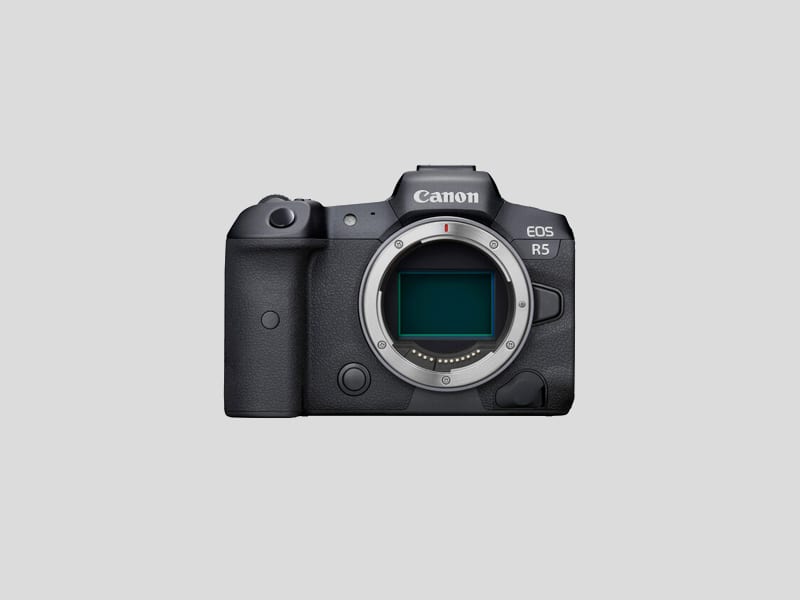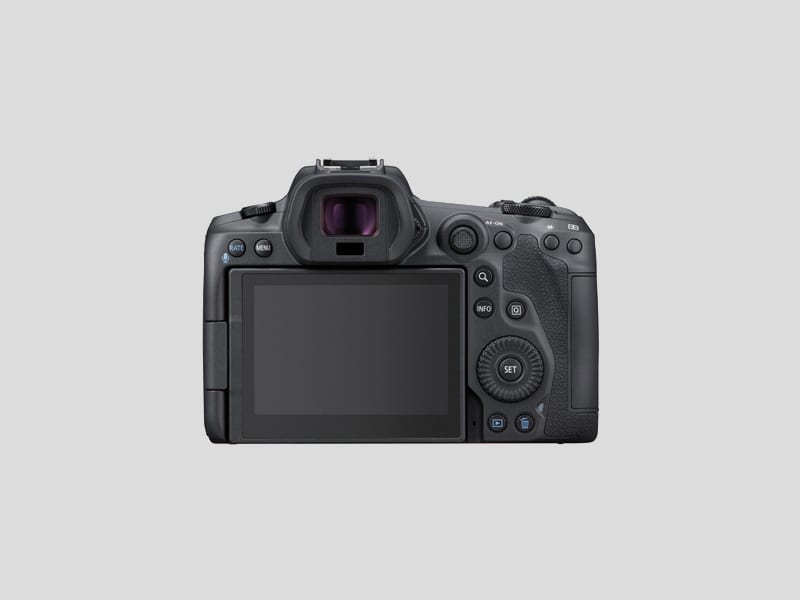CANON EOS R5 Mirrorless Camera
For the first time ever, Canon has given the name Canon EOS-5 series to its Mirrorless system. The EOS R5 is a worthy contender for top mirrorless technology and offers the highest resolution EOS R camera to date.
The Canon EOS R5 Mirrorless Camera is a 45 MP full-frame mirrorless camera that shoots full-width 8K video. It has next-generation Dual Pixel autofocus and a stabilization system that provides up to eight stops of shake correction with a variety of lenses. It can also capture 10-bit HDR stills and video for HDR display. Canon designed it keeping professionals and amateurs who wish to spend enough in mind. The Canon EOS R5 Mirrorless Camera is a successor to the 5D-Series of DSLR cameras and has definitely shaken the competition up with its stunning features.

The headlining feature is definitely its video capabilities. The R5 can capture uncropped raw 8k video using the entire readout of the 35mm sensor. Since the 8k DCI video has a resolution of 8,192 x 4,320, the camera has a Frame Grab function that enables you to take high-resolution 35.4MP stills (as JPEG) from your footage. There is a brand new 45MP Image sensor, which Canon suggests makes R5 the highest-resolution EOS camera ever. The new low-pass filter design was introduced in the flagship Canon EOS-1D X Mark III. Traditional low-pass filters use dual-layer, four-point subsampling and introduce a layer of softness to images. Canon’s new tech features quad-player, 16-point sampling, and combines it with a Gaussian distribution technique to deliver sharpness rivaling the 5DS/R.
The Canon EOS R5 feature’s the latest and long overdue implementation of 5-axis in-body stabilization. You get the best stability using specific RF-mount glass, the IBIS works with EF lenses, as well as dumb lenses with no electrical contacts, essentially any lens such as vintage lens, cinema lens, or lenses adapted from other camera systems.
The weight of the EOS R5 is evenly distributed. And while it may seem chunkier, it is very well balanced. The extra mass gives it the edge to match large RF lenses. From the top, the R5 is very similar to the EOS R and bears the same top OLED screen and mode button within the rear control dial. It’s the rear where the differences start to come into play, and the first thing you’ll notice is that the love-it-or-loathe it M-Fn touchbar has been abolished; in its place is a familiar joystick, with the AF-ON button assuming its more traditional position.
There are certain drawbacks to the EOS R5. Shooting anything above standard 4K 30p video will cause the Canon EOS R5 to heat up internally, thus making it necessary to have recording limits. This will avoid overheating.

Shooting 4K 30p causes no overheating issues whatsoever, so you can shoot as much video as you like (all recordings are subject to the usual 30-minute limit per single file, but you can record as many 30-minute files as you like). However, limitations will be incurred the more demanding your video settings. So shooting 4K 60p will cause the camera to overheat in about 35 minutes while shooting 8K 30p will result in overheating in about 20 minutes – after which you will need to allow the camera to cool down before recording again. There are other video restrictions worth being mindful of – you can’t record the more demanding video modes (RAW, 8K 4K 120p, and so on) unless you’re using a CFexpress card, so bear that in mind if you’re using SD.
Photographers can’t record video to both cards mentioned above, to create a redundant backup, so they will have to get used to shooting or working with proxies. There is also the inherent risk that a card failure or issue could cause complete loss of work and data. Photographers also can’t record 8K or 4K footage using EF-S lenses, as this crops the recording area, or with movie cropping enabled (which obviously does the same).
But everything apart from these issues looks perfect. For example, the 35MP Frame Grabs that you can extract from 8K video. This is a technology that has been seen in other cameras before, but never with the level of detail and quality seen here. Simply scrub through your 8K footage on the back of the camera, pinpoint the frame you want as a still, and push a button to produce a 35MP image – and it isn’t the kind of blurry, low-res still you get when you screenshot a YouTube video; it’s a pristine high-resolution file that looks like it was taken as a photograph on a camera with a very, very good 35MP sensor.
Canon has clearly hit it out of the park with this one. For photography, it is absolutely the camera to beat. While the A7R IV is has more megapixels, and the 5D Mark IV has superior ISO and dynamic range, the wide range of properties of the R5 – the resolution, frame-rates, IBIS, autofocus – make this hands-down the king of all-round, high resolution, high speed photography.
